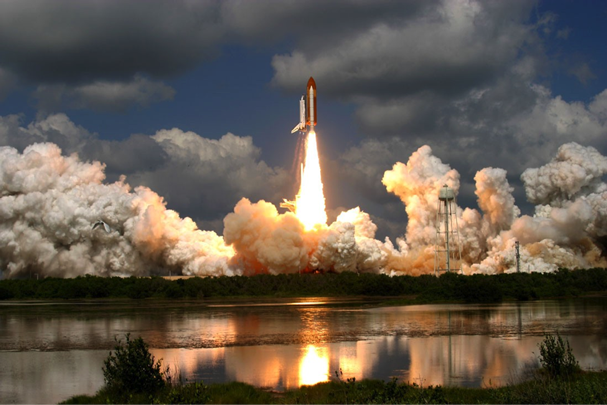-
WHAT IS NASA PHYSICS?
-
MODULES
-
Forces and Motion
-
Conservation of Momentum & Energy
-
Temperature and Heat
-
Fluids
-
Optics
-
Electromagnetic Spectrum
-
Modern Physics
-
Anticipation Guide 7
-
Intro to Modern Physics
-
Blackbody Radiation
-
The Ultraviolet Catastrophe
-
The Photoelectric Effect
-
Bohr's Atom
-
Spectra
-
Radioactive Decay
-
Special Relativity (SR)
-
Simultaneity
-
Distance and Time
-
General Relativity
-
May the Forces be with You
-
Modern Physics Notebook
-
Assessment Problems 7
-
-
Useful Things
-
-
SITE MAP
Forces and Motion
-
Anticipation Guide
-
Speed and Velocity
-
Acceleration
-
Gravity
-
Projectile Motion
-
Orbital Motion
-
Newton's Laws of Motion
-
Assessment Problems
Equation
acceleration = velocity—————
time
a = v—t
1.3
Acceleration

Description
When the Space Shuttle is launched the main goal is to quickly accelerate it to a high enough velocity to enter orbit around the Earth.
Changes in movement require a force. That’s right, nothing in the universe moves without some force being applied to it at some time. We just saw that speed or velocity is a change in distance divided by a change in time (v = d / t). Now, we introduce a new term, “acceleration”. When you apply a force to an object, the object accelerates. Acceleration is just the change in velocity divided by the change in time.
We can write it this way:
acceleration =velocity——————
time a = v—t This should look vaguely familiar since it is very similar to the equation for velocity. In this way, all accelerations are AVERAGE accelerations because to compute acceleration you must have a change in time even if it is a very small change.
© 2013 by Wheeling Jesuit University/Center for Educational Technologies®. 316 Washington Ave., Wheeling, WV 26003-6243. All rights reserved. Privacy Policy and Terms of Use.

